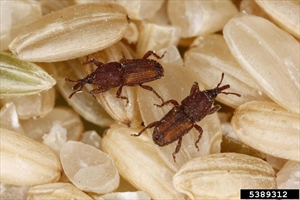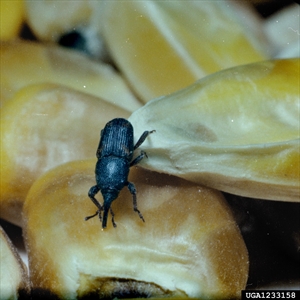- Worldwide distribution. On rice, maize, sorghum, wheat, cassava, and other stored products. Important weevil.
- Destructive: attacks sound grains, leaving large cavities, allowing secondary invasions by insects, mites, and fungi.
- Eggs laid into holes chewed in grain, and then plugged. Larvae feed inside the grain, and pupate there. Adults, up to 4 mm, reddish-brown to black with four light-reddish to yellowish spots on the wings.
- Spread with movement of stored grain; the weevil is not a strong flyer.
- Cultural control: harvest at maturity; dry to 12%; keep storage rooms and areas clean; spray bins, and use new sacks; if infestations occurs, locate and treat: if small - sieve, freeze or wrap in plastic and bury; if large, fumigate. Store small amounts of grain in plastic containers.
- Chemical control: consult full fact sheet for details; always check whether the product is for treating equipment, bins and buildings or for treating grain for human use and animal feed. READ THE INSTRUCTIONS.
Pacific Pests, Pathogens, Weeds & Pesticides - Online edition
Pacific Pests, Pathogens, Weeds & Pesticides
Rice (lesser grain) weevil (338)
Rice weevil, lesser grain weevil, small snout weevil
Sitophilus oryzae; a similar species (Sitophilus zeamais) attacks maize (see Fact Sheet no. 339).
AUTHOR Grahame Jackson
1Information from Swaine G (1971) Agricultural Zoology in Fiji. Her Majesty's Stationery Office. London; and CABI (2015) Sitophilus oryzae (lesser grain weevil). Crop Protection Compendium (https://www.cabi.org/cpc/datasheet/10887); and Rickman J, Gummert M (undated) Pest management in storage. IRRI. (http://www.knowledgebank.irri.org/search-results?gsquery=common+post+harvest+insects); and from DPI&RD (2019) Insect pests of stored grain. Agriculture and Food. Government of Western Australia. (https://www.agric.wa.gov.au/pest-insects/insect-pests-stored-grain). Photos 1&2 Clemson University - USDA Cooperative Extension Slide Series, Bugwood.org; Photos 3&4 Walker K (2006) rice weevil (Sitophilus oryzae): PaDIL - (http://www.padil.gov.au).
Produced with support from the Australian Centre for International Agricultural Research under project PC/2010/090: Strengthening integrated crop management research in the Pacific Islands in support of sustainable intensification of high-value crop production, implemented by the University of Queensland and the Secretariat of the Pacific Community.








